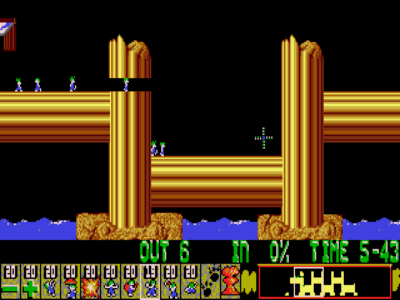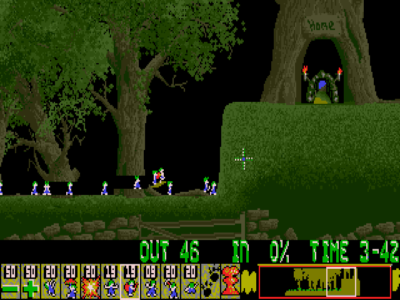
Lemmings
Written by: Stoo
Date posted: May 5, 2007
- Genre: Strategy
- Developed by: DMA Design
- Published by: Psygnosis
- Year released: 1991
- Our score: 8
Five years after starting this site, we’ve reached a point where we think we’ve mostly covered our childhood gaming favourites. Not that we’ve run out of oldies to review, not by a long shot. We’re just mostly done with those we had actual first-hand experience of playing back in the early 90s. However, recently in a dull moment at work, I slapped myself around the head and realised “d’oh! Lemmings!”. I’m not sure why it’s taken us this long to get around to reviewing such a famous classic. Especially as its own sequel was one of the very first games I wrote about for this site. No rational explanation, really, but at least I can try and fix such a glaring omission.
Lemmings was created by DMA Design, now known as Rockstar games, the team behind the controversial Grant Theft Auto series. It was in its day incredibly popular, and was released on just about every possible gaming platform. Amiga owners probably had the best version (they normally did, the bastards) with better music, 2-player options and an animated intro sequence. There were ports for all the consoles of the day; although given that the interface is pointer-based I would have thought their controllers would make life difficult. Also Atari ST (sound of Rik cheering), Speccy, a few more, and of course the PC. From here, it would go on to spawn a legion of sequels.
Lemmings was based on some fairly original ideas. You’re presented with 2D side-view of a level, full of obstacles, pits and hazards. At first glance, it’s a lot like something you might expect of a platform game, but the gameplay is in fact very different. A hatch opens, and lemmings tumble out one at a time, anywhere between a handful and eighty. For the most part you have no direct control over them; they just happily blunder along. If they hit a wall they’ll turn around and go back the other way. If they reach a drop they’ll mindlessly step off, and get squished on impact if the distance fallen is too far. Water is deadly to them, as are various traps that may be scattered amongst the level.

This one is should be pretty easy to figure out.
Your mission on each level then, is to get a specified percentage safely to the exit. To accomplish this, a range of skills are available which you can give to a lemming, with a click of your mouse. However these can only be handed out a finite number of times on each level, forcing you to plan their use carefully. Three of the skills are variants on digging – horizontally, or vertically or diagonally downwards. The lemming will chew threw the scenery until there’s nothing left to dig, or given another task, so you’d better make sure they don’t end up tunnelling their way off the bottom of the screen or into a lava pit. Another skill builds a ramp diagonally upwards, out of twelve little bricks. You soon learn to listen carefully“click, click, click” of the last three bricks, poised and ready to hit build again if the bridge hasn’t yet reached wherever you need to be. On top of that there’s climbing, and the ability to safely float down any drop; these skills once awarded last for the duration of the level. Blockers simply force incoming lemmings to turn around as if they hit a wall, and exploders… blow up. Which seems heartless, but sometimes you need to blow a hole in something, and it’s one of the only ways to remove a blocker who has served his purpose.
The learning curve is a gentle one with the first group (designated “fun”) being very easy. Although Lemmings comes from a time before official “tutorial” sections were common in gaming, the first few maps pretty much serve that function. Each makes one or two skills available, in a simple situation where it’s obvious how you must use that skill to reach the exit. The rest of the group presents a wider range of challenges, but levels generally give you easy goals, plenty of skill uses etc so you’ll probably cruise through the lot within a couple of hours.
From here though the difficulty ramps up significantly – through three more groups: tricking, taxing and mayhem. You realise you need swift, accurate clicks to assign skills in time – for example you might send a lemming tunneling through a wall, then have just a couple of sections to assign him as bridge builder before he plummets off a cliff. There’s also crowd-control to consider; generally lemmings move faster than those that are working can make a path, so you might have to pen the rest of them in somehow whilst one or two build and tunnel. Where it really gets hectic is when you’re forced to dart back and forth between action happening in several places at once, especially if there’s more than one entry point for the lemmings.

A tribute to Shadow of the Beast.
Be prepared to fail the harder levels many, manny times over before you crack the solution of how to make a safe route across with your limited resources. In fact sooner or later you’ll probably find yourself reaching the stage of wanting to throw your monitor through a window and planting foul curses upon the heads of the developers responsible for your torment. What’s more, I must confess I’ve not completed this game. Quite a way short of that, in fact. Still in a puzzle game it’s a challenge that we’re after, right? If you romped home within a day you might feel somewhat cheated.
If a map is really frustrating you, there is always the infamous “nuke” button. There’s a five-second countown, then the lemmings all go “oh no!” and explode, taking out lots of the scenery with them. Well, they say “oh no” on the amiga at least, on PC it’s a squeak that vaguely approximates to that. Anyway this function doesn’t actually have a practical use, as you can just as easily hit escape to restart the level. It’s really just a much-needed stress-release valve.
This all sounds very praiseworthy, but there is one gameplay flaw that pisses me off. You might often find the lemmings are moving around together in one huge mob. It depends on the layout of the land, and also the rate at which they enter the level, which is partially but not fully under your control. That means you can’t really choose a single lemming. That often won’t matter if they’re all going the same direction. However, imagine the lemmings are all stuck in a narrow, steep-sided pit. You might need to dig a tunnel into one of the walls – but because they’re all changing direction at that wall, you have no way of knowing which way the chosen lemming will be going. It just comes down to a 50/50 chance. If you’re unlucky, and you can’t afford to waste a use of the tunnelling skill then, well, that’s that effort screwed. Time to restart, and hope you’re luckier next time. It’s not a game-killing issue – maybe you can let one lemming ahead of the mob to do the tunnelling and hold the rest back with a blocker – but it does crop up often enough to be annoying.
That’s the gameplay covered, but I have to speak up for the game’s aesthetics. Yep, even though it’s seventeen years old. The game is old-skool 2D for sure, with black backgrounds and limited by the EGA palette, but I still think it has a definite visual charm. The artwork is well done, and there’s a wide variety of design styles for the maps. Some are earth-and-rock based, others stone and broken greek-style columns, others a little more fantastical like some kind of crystalline structure. The lemmings themselves are about eight pixels tall, but manage to pack a surprising amount of charm into such a small space.

Much easier than going the low path.
The music has to be mentioned too. As with most PC games of the time it’s generated via the midi protocols by FM synthesis – this was in the days before pre-recorded and digitised music (like our mp3s of today) was a practical option. So on the technical side it can sound rather basic, and those smug bastard Amiga owners were probably laughing. There are still however some great, catchy tunes that make the most of the technology that was then available.
Despite that one annoyance listed above, Lemmings is one of those oldies I can comfortably use terms like “enduring classic” to describe. It’s fun in a silly way – ridiculous creatures blundering around and falling off cliffs, and also highly addictive in that “just one more go” fashion. Some kinds of game in our opinion don’t age all that well, but to me this one has a winning format that’s still enjoyable today.


 Posts
Posts